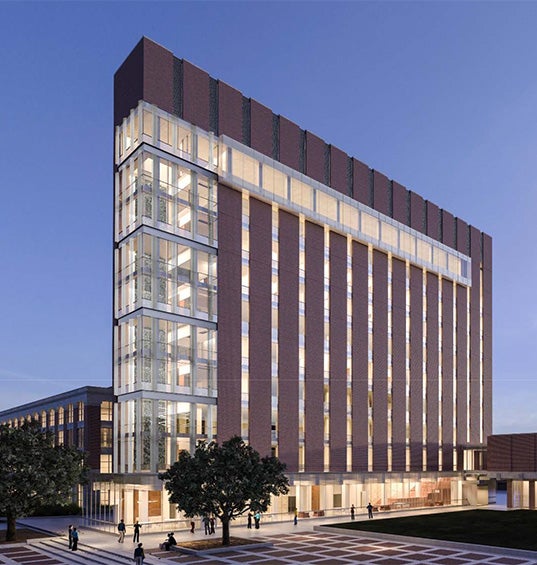KEY BUILDING STRATEGIES
- Create an engaging and active first floor
- Enable a wide variety of activities through flexibly designed multipurpose rooms
- Create a welcoming entry point with information about events and opportunities
- Connect students to opportunities and services through advising outposts
- Zone floors to provide access to natural light and facilitate interaction
- Encourage serendipitous interaction throughout the building
- Provide a customizable “home base” for each unit to express their identity
- Create active hallways to direct people, share information and make work visible
- Design flexible offices to support different work styles
- Establish a center of activity for building residents
Weiser Hall will be an active, tech-enabled hub that encourages different types of interaction across groups of people, geography, and disciplines, offering new opportunities to students. Key guiding principles are outlined below.
PEOPLE
Support people with a shared sense of how their group identity relates to a global vision while bringing renewed focus to the undergraduate experience.
- Undergraduate focus: Create activities and programs to further engage students in international programs.
- Individual centers: Acknowledge and support the identities and communities of each unit while imagining new possibilities for growth.
- Inter-center collaboration: Facilitate connections across groups to enable continued development of cross-regional programs.
- Faculty: Provide a destination and hub for faculty affiliated with Weiser Hall units, drawing faculty to the building for events, as a place to work, and as a place to connect with colleagues and students.
ACTIVITIES
Facilitate activities that create a lively and dynamic atmosphere, including formal and informal collaboration, events, study, and support services
- Performance: Cultivate relationships between people and create a lively atmosphere by incorporating events, activities, and programs into the fabric of the building.
- Projects: Provide project-based collaborative spaces that can be used by units focused on similar themes to work in an integrated way.
- Unstructured activities: Allow for random connections through the collocation of activities and by avoiding over-prescription of use (e.g. allow users to modify space).
- Learning: Weiser Hall should embody the “learning building” of the future, encouraging active and project-based learning, international activities, technology-rich, real-world problems across disciplines and subjects.
- Individual work: Support the need for privacy and focused work for staff, faculty and students.
CULTURE
Foster a culture that is globally engaged and supports different kinds of collaboration – across disciplines, among staff, within research teams, and among students.
- Local / Global: Foster a culture that bridges regional studies with transnational/global studies by leveraging the extraordinary depth and breadth of the people within the building, balancing “context” with “comparison.”
- Celebrating Culture: Provide visual cues and support activities that increase awareness of the values, identity, interests and knowledge of each center.
- Unpack collaboration: Enable and support varied groups of people with different collaboration needs, by providing the different spaces, technology, norms, and services needed: cross-unit project-based collaboration, efficient staff collaboration via shared resources, and faculty and student mentoring in classes and research labs, to name a few.
SERVICES
Enable work processes to be more fluid and fast so that services can be more apparent and accessible. Expand processes to enrich and support academic communities within and across units.
- Center of Centers: Bring together and align centers to enhance the programs and opportunities available for undergraduate students.
- Student Services: Provide services that help students navigate the University and provide a “one-stop-shop” for international activities and related services.
TECHNOLOGY
Provide technology that acts as a gateway and seamless connection between people and ideas.
- Ease of interaction: Incorporate technology that enables quick and seamless learning and interaction.
- International Connection: Provide the tools to enable Weiser Hall to be a technology enabled window on the world, a “gateway.”
- Support working and learning everywhere: with adaptable, mobile, and ubiquitous technology.
- Productivity Tools: Provide the tools needed for people to efficiently and effectively use the space provided (e.g. smart room booking systems).
- Flexibility: Develop a technology strategy that adapts to the new and unexpected ways in which students use technology.
SPACE
Create a welcoming, “magnetic” place that draws a variety of people to Weiser Hall and facilitates both their interaction in shared spaces as well as their focus in private spaces.
- Enable interaction: Co-locate centers of similar interest and missions and break down physical barrier within the building, while addressing the physical limitations of Weiser Hall.
- Create a welcoming, magnetic place that “throngs with action,” traffic, and conversations by welcoming a variety of people, enabling multiple kinds of use and attracting a critical mass of people.
- Visibility on campus: Establish a presence on campus that extends beyond the constraints of the building.
- Variety: Provide the appropriate balance of collaborative, concentrative, and social spaces.
- Support faculty: A place where faculty feel like they belong but don’t necessarily need to own an individual space – where they can work, independently and in groups, and talk to other faculty and peers in their areas of study.
For additional visioning details, read the LSA Dennison Future State Report created in June 2013 (when the building was still named Dennison).



